List of Authors
>>About this blog
Recent blog post
|
[Slow of Satsuki's Koi]
Nov. 24, 2015 09:00
Suitengu Shrine is familiar with praying for safe delivery. Since March 2013, it has been relocated near Meijiza Hamacho for rebuilding work.
・

・
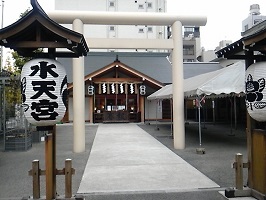
・November, 2015
This under construction now, a part of the scaffold was removed and a beautiful appearance was seen.
I took this photo in October, but I think the scaffold was removed in September. It looks like this as of November.
The completion of the new shrine hall will be in the spring of 2016.
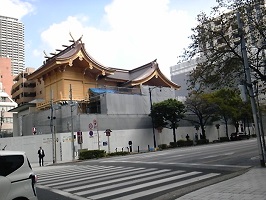
From Suitengu (November 20, 2015), you will find Koami Shrine when you pass amazake Yokocho toward Nihonbashi River.
One of the "Nihonbashi Seven Lucky Gods" is the benefit of repelling bad luck and increasing luck. This is also under restoration work.
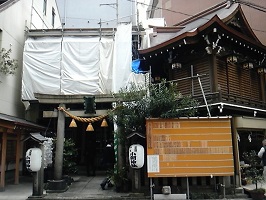
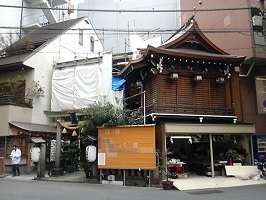
During the construction period, you can worship as usual, and when you took a picture, some people came to visit.
It is scheduled to be completed in November, so it may be completed when this blog is uploaded.
[CAM]
Nov. 23, 2015 14:00
Monument to the site of the U.S.
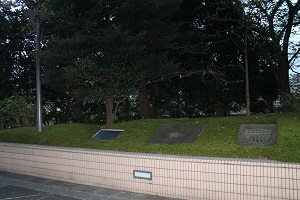
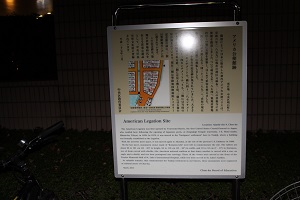
"Harris, the first U.S. minister who was stationed in Japan at the opening of the port, opened a ministerial office in Zenpukuji Temple in Motoazabu 1.6, Minato-ku in 1859 (1859). By the way, in December 1875 (1875), a public hall was newly built in this area in the Tsukiji settlement, and the shape was adjusted for the first time.
Later, this became too small, and in March 20111, he moved to his current location in Akasaka (U.S. Embassy).
There are five monuments of Komatsu stone at the ruins of this ministerial hall. The size is 86-101 cm long, 84-118 cm wide, 18-34 cm thick, two of which are shields, the US national emblem of the time, stars, eagle and shields, and 2 are engraved with Goryo stars.
This monument is registered in the central ward Tangible Cultural Property as a valuable relic of the settlement period of Tsukiji.
March, 1996
Chuo-ku Board of Education
The birthplace of fingerprint research (8-1 Akashi-cho)
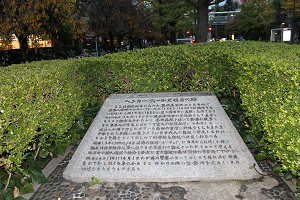 "The trace of the Henry Falls residence "The trace of the Henry Falls residence
This is the 18th place of Tsukiji Reservation in the early Meiji era, where the British doctor Henry Falls (1843-1930) lived during his stay in Japan from 1874 to 1886.
Falls came to Japan as a missionary of the Scotland Condensed Elders Church, opened Tsukiji Hospital in addition to Christianity missionary work, engaged in medical treatment, and worked with Japanese volunteers to educate the blind.
He was interested in the custom of fingerprinting in Japan and discovered the fingerprints of ancient people who were impressed by the pottery that happened to be excavated, and inspired by this, he studied scientific fingerprints for the first time here.
It was
In October 1880 (1880), his paper submitted by Japan to the British magazine "Neture" in October 1880 is said to be the world's first paper on scientific fingerprinting, among which he announced the experience of personal identification of criminals as soon as possible. April 1, 1911 (1911), which also mentions the genetic relationship of fingerprints, the first time since the 50 was adopted in Japan's.
The birthplace of Meiji Gakuin (7-16 Akashicho)
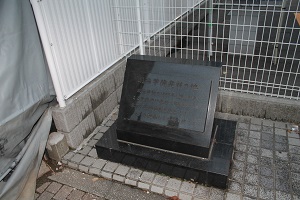
"The birthplace of Meiji Gakuin
Meiji Gakuin was founded in 1877 (Meiji 10).
It was opened here at 17 former Tsukiji.
Based on the Tokyo Matching Shrine
To commemorate this, we will build this monument."
Catholic Tsukiji Church Cathedral (5-26 Akashicho)
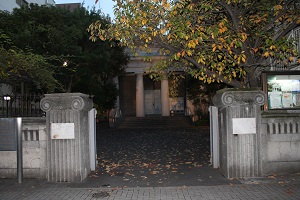

"The predecessor of the Catholic Tsukiji Church was the Inaribashi Church, which was opened in 1871 by Father Maran of the Paris Foreign Mission in 1871 by renting a merchant near Inari Bridge in the gunshot. In 1874 (1874), the priest rented Tsukiji Reservation No. 35 and 36 under the name of the missionary, and built a priest's house and a cathedral here. In 1878 (1878), a Gothic-style cathedral was dedicated here, which was destroyed by the Great Kanto Earthquake, and the current cathedral was rebuilt in 1927. The cathedral looks stone, but it is actually a wooden building, and the mural is painted with mortar.
The bell used in the old cathedral was made in Renne, France in 1876 (Meiji 9), and was named "Janne Louise of Edo" by Father Mareshal, the priest at the time, and is still kept in the church.
The church cathedral and bells are registered as Chuo Ward Cultural Properties as valuable cultural properties left in Akashicho, where the foreign settlement was once located.
March, 2001
Chuo-ku Board of Education
Tsukiji Foreign Settlement Site (Akashicho 1-15 Akashi Elementary School)
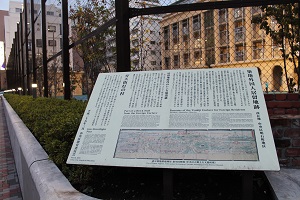
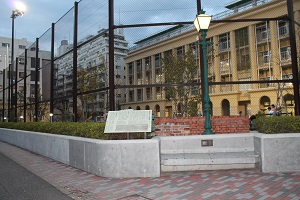 In 1858 (1858), the Edo Shogunate signed the Osamu Yoshi Trade Treaty with five Western countries, and agreed to open five ports, including Yokohama and Kobe, and to open Edo and Osaka. The settlement was a special zone set up on the open and open land for the residence and commerce of foreigners in the treaty signing country. In 1858 (1858), the Edo Shogunate signed the Osamu Yoshi Trade Treaty with five Western countries, and agreed to open five ports, including Yokohama and Kobe, and to open Edo and Osaka. The settlement was a special zone set up on the open and open land for the residence and commerce of foreigners in the treaty signing country.
Edo (Tokyo) opened in 1868 (1868) after the Meiji government became the Meiji government, and based on this treaty, the current Akashicho area was designated as Tsukiji settlement.
Unlike Yokohama and Kobe, where many commercial centers were located, Tsukiji Reservation is home to intellectuals such as missionaries, doctors, and teachers from overseas, including foreign ministerial embassies and consulates, and open many churches and schools to educate. Was. For this reason, the Tsukiji settlement formed a region that had a major impact on the modernization of Japan.
From the copperplate prints of Tsukiji Reservoir drawn in the Meiji era, you can see the state of a city full of exoticism with Western-style architecture.
March, 2003
Chuo-ku Board of Education
The land of Shuyo Gakuen's launch
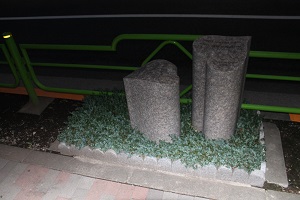
"In virtue is pure
In a mandate
1909
SIMPLE DANS MA VERTU
FORTE DANS MON DEVOIR
Berceau de Futaba
1909 」
[CAM]
Nov. 21, 2015 18:00
Birthplace of Women's Academy (Akashicho 10)
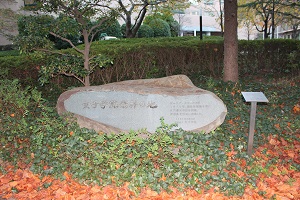
"Julian Karo Sols was in 1870.
Founded A 6th Girls' School in Tsukiji Reservation No. 6.
He was a member of the U.S.
October 24, 1999 Women's Academy
The birthplace of Rikkyo Gakuin (Akashicho 10)

"Open the 1874C.M. Williams Primary School
Be a servant of everyone Gospel by St. Mark 9:35
This monument will be built to commemorate the 125th anniversary of its founding.
December 2, 1999 Primate Williams Memorial Day
Rikkyo Gakuin
Monument of origin of Dutch studies (11 Akashi-cho)
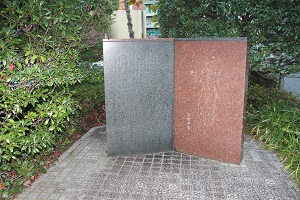
"In 1771 (1771), Ryotaku Maeno, a physician of the Nakatsu clan in Buzen Country (Oita Prefecture), together with Genpa Sugita and others, the Dutch dissection "Tarher Anatomia" was completed in the Nakatsu clan Okudaira family Shimo-yashiki (later Akashicho's new land) and "demolished."
The translation at that time was described in Genpaku's book, "The Beginning of Dutch Studies", and this place can be said to be the place where the birth of modern medicine was laid.
Chuo-ku Board of Education
The birthplace of Keio University (11 Akashi-cho)
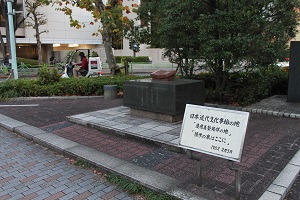
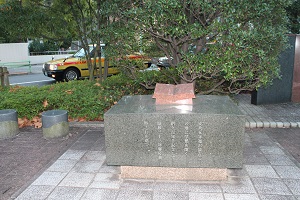
"In 1858, Yukichi Fukuzawa opened a school in this area.
In commemoration of its 100th anniversary, Keio Gijuku was built in 1958.
The origin of Keio Gijuku is derived from the Dutch studies school opened in 1858 by Yukichi Fukuzawa in Nakayashiki of the Okudaira family of the Nakatsu clan. It is located on the premises of the Northeast St. Luke's International Hospital. This area is also a historic place where Ryotaku Maeno, a doctor of the Nakatsu clan, first read the Dutch anatomy book in 1771, and is a memorable place as the birthplace of modern Japanese culture.
April 23, 1958 Unveiled
St. Luke Chapel and Toysler Memorial Hall, St. Luke International Hospital
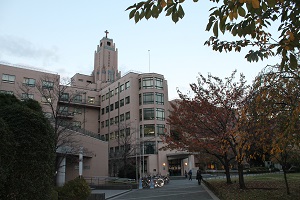
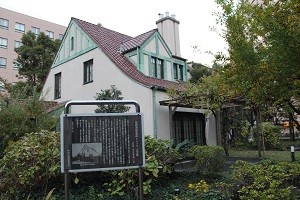
"In 1933, the Toysler Memorial Hall was built at 19 Akashi-cho on the banks of the Sumida River as a missionary hall at St. Luke International Hospital.
The designer was an American architect J. V. W. Bergaminy, and the enforcement was carried out by Shimizu Gumi (now Shimizu Corporation). The skeleton of the building was a two-story reinforced concrete wooden building, which is rare for residential buildings in the early Showa era, and was a solid-style building reminiscent of a European mountain cottage.
Demolition work was carried out in 1989, and it was relocated and restored to its current location in February 1998. In restoring, we accurately record the construction technology and structural features at the time of its foundation, and use reusable materials as much as possible.
The exterior is a half-timber-style design that expresses pillars and beams outside. The interior is designed with a tuder gothic style, and the interior of the wood is seen in the entrance hall and living room.
This building tells the history of St. Luke International Hospital and is a valuable cultural property that conveys a part of the history of Akashicho, which has been handed down since the Tsukiji Reservation period.
March, 2006 Chuo-ku Board of Education
[CAM]
Nov. 21, 2015 14:00
I stepped through "Monoshiri Encyclopedia" and "Chapter 1 Walking in Chuo-ku" little by little, and wanted to keep it in a record. .
For the time being, I started with "Shintomi / Akashicho" that I knew without permission. Although we left around 3:30 today, the sunset in autumn was early, and the second half was already falling. In addition, the arrangement of photographs and inscriptions takes a considerable amount of time, and although it is a break of time for the poor elderly, it seems that it will last forever, but for the time being, it is the first time.
Needless to say, it is not possible to provide new information now, but since Monoshiri Encyclopedia does not include photos of all points, it is meaning to convey the current status of all points in principle. May be. In addition, the Chuo-ku Board of Education seems to be replacing the bulletin board with the one with the English text, but some of the following are the same as before. Don't be wrong.
Shintomiza Ruins (2-6-1, Shintomi)
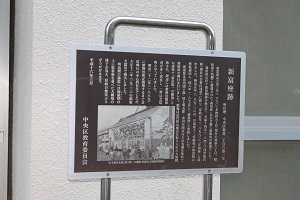
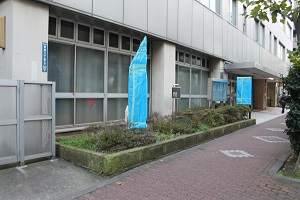
"Shintomiza was a Kabuki theater that took over the Morita-za, which was founded in 1660 in Kibikicho 5-chome (currently Ginza 6-chome, west of Showa-dori).
Morita-za was led by Kanya Morita for generations, moved to Asakusa Saruwaka-cho (currently Asakusa, Taito-ku) in 1843 (1843), and changed to "Morita-za" in 1858 (1858). . In 1872, Kanya Moritaza, the 12th generation of Kanya moved to Shintomi-cho, and in 1875 it was renamed Shintomi-za.
Shintomiza gathered famous actors such as Danjuro Ichikawa, Kikugoro Onoe, and Sadanji Ichikawa and performed aggressively. . The theater is a large-scale building with a modern style and is called "Tokyo's first theater", and there were many Kabuki officials living in the surrounding area, and the whole area was a play town.
Until the Kabukiza opened in 1889 (1889), it was a central player in theater performances, but was destroyed by fire in the Great Kanto Earthquake of 1923 (1923).
In the Nishiki-e of the Meiji era, you can see a large theater with picture signs lined up on the sea rat wall, indicating the prosperity of the past.
March, 2004
Chuo-ku Board of Education
The birthplace of the shoe business (Irifune 3-2-10)
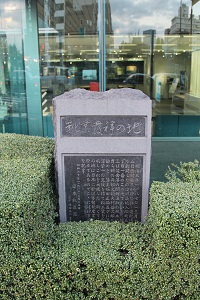
"On March 15, 1870 (1870), Katsuzo Nishimura founded Ise Katsu / Soshokujo was the former site of 5-1 Tsukiji Irifunecho. Katsuzo created the shoe industry with the recommendation of Daisuke Hyobu Masujiro Omura when he grew up in the culture of the opening of the Sakura Domain, and the support of Masanori Hottafeudal lord and Eiichi Shibusawa. In this way, this area is the starting point of the shoe industry in Japan, so the monument is recorded here.
March 15, 1985 (1985)
Japan Shoes Federation
Ruins of Takumi Asanouchi's residence (Akashicho 10/11 area)

"Hitachi Kasama (Kasama City, Ibaraki Prefecture) feudal lord Naganao Asano (1610-72) was relocated to Harima Akaho (Ako City, Hyogo Prefecture) in 1645 (1645), and occupied 53,500 stones. Was called. It is divided into 50,000 stones for the child Nagatomo.
From here, the area of 8,900 tsubo, including St. Luke International Hospital in the northwest and the riverbank, was the place where the Edo Kamiyashiki of the Asano family of Akaho feudal lord was located, and the two southwest sides facing the Tsukiji River.
Takumi Asanouchi (1665-1701), famous for Chushingura, was a child of Nagatomo, who was promoted to entertain the Imperial Envoy in 1701 (1701), but on March 14, Yoshio Kira, who was the leading role, was cut off in Edo Castle. This Edo mansion and territory were taken up, and the Akaho feudal lord Asano family was cut off.
March, 1995
Chuo-ku Board of Education
The birthplace of Ryunosuke Akutagawa (10 Akashicho)

"Around 1883 (1883), there was a dairy cow ranch called Komakisha near here (8-1 Irifunecho, Kyobashi-ku at that time). Writer Ryunosuke Akutagawa (1892-1927) was born here on March 1, 1892 as the eldest son of the owner, Toshizo Niihara.
Seven months after birth, Ryunosuke was taken over by his mother's eldest brother, Michiaki Akutagawa due to family circumstances, moved to Koizumimachi, Honjo-ku (currently 3-chome, Ryogoku, Sumida-ku), and at the age of 12, adopted by the Akutagawa family. Was.
While studying at Tokyo Imperial University, he became familiar with writing and entered the gate of Soseki Natsume, and left many masterpieces such as "Hell Change", "Rashomon", "Kappa", and "The Life of Organ". On July 24, 1927, he committed suicide at the age of 35.
March, 1996
Chuo-ku Board of Education
[Sam]
Nov. 21, 2015 09:00
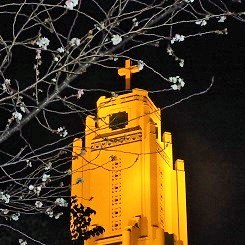 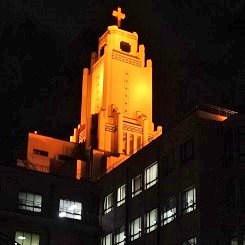
 "St. Luke's International University (formerly St. Luke's International Hospital) St. Luke's Chapel" was established in 1902 as a chapel of St. Luke's Hospital, founded in 1902 by Toysler, a missionary doctor of the U.S. "St. Luke's International University (formerly St. Luke's International Hospital) St. Luke's Chapel" was established in 1902 as a chapel of St. Luke's Hospital, founded in 1902 by Toysler, a missionary doctor of the U.S.
The current chapel is a Neo Gothic style built in 1936 after the Great Kanto Earthquake of 1923 and a fire two years later. (Decorating is an art deco style)
At that time, you can see the cross on the roof of the hospital from any hospital room, and it is said that it was a mental support for the patient.
Currently, there are two "places of prayer": "Chapel (chapel)" on the 2nd floor of the old building of the hospital and "Toysler Memorial Hall (completed in 1992 <Korea Hall>) on the 2nd floor of the new building.
As a place to find the ability to respond to various problems, including illness, while calming and praying, we continue to play a role as a place for revelation of the mental pillars of medical care and education held at St. Luke International Hospital / International University.
The two "places of prayer" are connected by the corridor.
In the recent redevelopment project for the entire hospital premises (St. Luke Life Science Center Initiative), the central part including the chapel of the old hospital building has been preserved and restored.
("Chapel and attached old ward" is selected by Tokyo Metropolitan Historic buildings)
From the tower of the old building, the melody of the choir flows every day at 8:30, 12:00 and 18:00.
In the evening, the spiral with a cross is lit up in orange, and clearly emerges in the night sky.
"October cherry blossoms" are planted in the courtyard.
It is said to be the subspecies of Kohigan, a hybrid of Edhigan and Mamezakura, and blooms intermittently small double-flowered flowers from October to early spring.
The flower color is white to pale pink, with 3 to 5 flowers blooming sparsely.
There is no gorgeousness, but with the illuminated chapel in the background, it creates a dignified atmosphere unique to this season.
There is a refreshing and harsh air.
[Minori]
Nov. 20, 2015 18:00
Hello, Minori.
This is the story of Fukutoku Shrine "Mebuki Shrine".
Fukutoku Shrine is located near Choredo Muromachi.
Fukutoku Shrine seems to have already been enshrined in the early Heian period, during the Jogan period of the Emperor Seiwa period (859-876).
It was enshrined as Inari Shrine in Fukutoku Village, which was a village of Musashino, and took the place name to Fukutoku Shrine.
The first Shogun Ieyasu Tokugawa visited our company for the first time in August 1590 (1590), when he entered Edo.
Since then, I have been visiting several times.
In addition, the second shogun Hidetada Tokugawa visited the shrine on New Year's Day 8, 1614 (1614).
He praised, "Fukutoku is a truly happy god."
At this time, I saw the spring buds sprouting at the skinned torii gate of Kuroki (sawtooth oak), an ancient example of Fukutoku Shrine.
The shrine is also known as "Mebuki Inari."
In February 1619 (1619), when he enshrined Benzai of Edo Castle, the Shogun himself delivered divine spirit.
He dedicated the banner of Yamato Nishiki, and stipulated that "shrines and temples Nawari is more than 333 tsubo."
It was popular because the lottery was officially recognized by the Shogunate as "Gomen wealth" in the Edo period.
Even now, many people come to visit this shrine if there is a lottery benefit.
The festival is the first noon in February and the annual festival in May.
In the fall of 2014 (2014), shrine hall was revived thanks to the efforts of local people in Nihonbashi.
There is Fukutoku Shrine on the north side of Cored Muromachi. There's shrine office in the foreground.
Chozuya, which cleans hands before worship, has a sensor that allows water to flow when people approach.
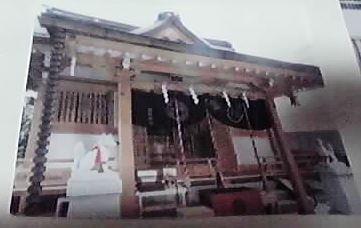
Fukutoku Shrine "Mebuki Shrine" enshrined deity Miyuo "Fukutoku Shrine shrine office" and Fukutoku Shrine historical book (stele) in the precincts of Fukutoku Shrine
SHOP & RESTAURANT GUIDE "& EARTH" and "Mitsui Fudosan"
"Chuo-ku Monoshiri Encyclopedia"
Refers to the Traffic Journal "Tokyo Traffic Safety Association".
|
Links
|


 "St. Luke's International University (formerly St. Luke's International Hospital) St. Luke's Chapel" was established in 1902 as a chapel of St. Luke's Hospital, founded in 1902 by Toysler, a missionary doctor of the U.S.
"St. Luke's International University (formerly St. Luke's International Hospital) St. Luke's Chapel" was established in 1902 as a chapel of St. Luke's Hospital, founded in 1902 by Toysler, a missionary doctor of the U.S.

